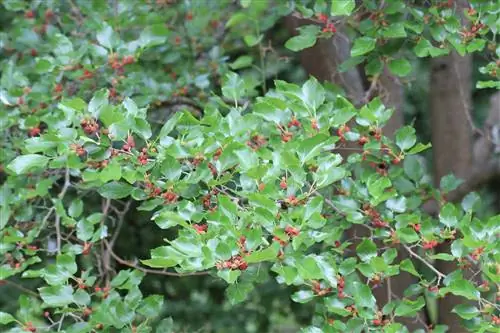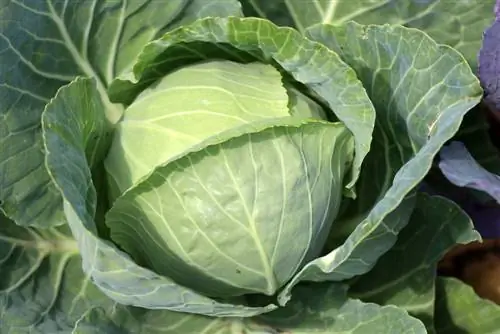- Author admin [email protected].
- Public 2023-12-17 03:39.
- Last modified 2025-06-01 06:48.
The mulberry tree comes from tropical and subtropical areas. Both the black and white mulberry trees were imported to our region many hundreds of years ago. In addition to the interesting leaves, which were originally used to breed silkworms, it is primarily the mulberries that have made this tree a regular guest in German gardens. Both black and white mulberries are edible and have many uses.
The white and black mulberry trees (Morus alba, morus nigra) are deciduous trees, which means they shed their leaves in autumn. The flowers are yellow and resemble pussy willows. In autumn, the trees produce white or dark red to black berries, depending on the variety. These berries can be harvested in summer, in the months of July and August.
The right location for mulberries
Both the black and white mulberry trees are among the robust garden plants. They can be planted outdoors as well as cultivated in a pot or container. The mulberry is hardy, so it can be left in the garden in the winter with appropriate cover. But overwintering indoors is also possible.
The ideal location for black and white mulberry trees in summer is partially shaded to sunny. Since the mulberry is very robust, the plant can be exposed to wind, so it does not need to be in a sheltered corner. The tree is very suitable for planting alone, as the mulberry develops a very strong, broad crown.
In winter the mulberry can remain in the garden, it is hardy down to around -15°C. Potted plants can overwinter in the apartment; overwintering in the basement is not necessary. The temperature for the location in the apartment should be around 5°C, but a cooler winter location is possible.
Caring for Mulberry Trees
The robust mulberry trees require little care. Regular cutting is not necessary. However, you can cut the branches or wild shoots annually. This cut is carried out in March to prevent the tree from becoming too tall. The growth of the shoots can also be controlled by annual pruning. The robustness of the tree also ensures that cutting has no negative impact on the development of fruit.
If you cultivate the black and white mulberry tree as a potted plant or place the tree on the terrace as a container plant, you will have to repot it regularly. The soil or soil in which the mulberry tree thrives best should be rich in humus and very well-drained. Adding gravel to the pot or bucket is a good way to ensure appropriate drainage.
In summer, mulberry trees kept in pots need to be watered regularly and very generously, as this plant's water consumption is very high. Watering 1 - 2 times a week is necessary, especially in the hot period of midsummer. Between March and around September, liquid fertilizer should be used weekly to ensure an adequate supply of nutrients.
In winter, care must be taken to ensure that the soil does not dry out completely. Outdoors as well as indoors during winter, the mulberry tree sheds its leaves in autumn, which severely limits its water requirements. Watering for houseplants should therefore be light but even. However, it is important to keep a close eye on the mulberry tree while it is overwintering indoors. When the first buds form in spring, water consumption increases significantly again. Then you have to react immediately with heavier watering. Fertilization is not necessary during the winter; this only starts again from March when the need for nutrients increases.
Cutting and propagating
The mulberry tree is one of the so-called wild trees. A distinction is made between the black mulberry tree (Morus nigra) and the white mulberry tree (Morus alba). There is also a red mulberry tree (Morus rubra) that comes from North America. The distinguishing feature is the color of the “berry-like” fruits.
From a botanical point of view, they are nuts. Another form or variant is the plane-leaved mulberry tree (Morus alba 'Macrophylla'). The white mulberry tree has been cultivated for silkworm breeding for thousands of years. The first trees were around 400 BC. Came to Greece from the Near East to Greece. From there they were spread via Italy to Central and Northern Europe. In Germany they were planted because of their reliable fruit production. The black mulberries in particular taste aromatically sweet. They can all be processed into dried fruits, juices, jelly, wine and compote and much more.
Short profile
The deciduous tree loves warmth, can reach a height of up to 15 meters and is characterized by a bizarre, gnarled growth habit. It is therefore often planted in an exposed location, such as in public spaces or as a house tree. Because its heart-shaped leaves provide shade. The mulberry tree blooms around May. Its blackberry-shaped fruits - a real delicacy - can be harvested from the beginning of August to the end of September.
Mulberry tree care
A fully sunny to semi-shaded place with a permeable, fertile - preferably calcareous - soil is suitable as a planting location. The mulberry tree is quite easy to care for. It even tolerates drought, heat, poor soils and inner-city climates very well. Mulberry trees that thrive in pots need to be watered often and abundantly as long as they are in full leafy condition. The bottom of the pot should be well moistened. Mulberry trees planted in the garden should be watered heavily once or twice a week in summer heat. Due to its high nutrient requirements, the mulberry tree should also be well fertilized. It is easiest to apply slow-release fertilizer in spring and early summer. It is also possible to supply compost or long-term organic fertilizer in March and June.
Cutting the mulberry tree
Pruning this wild tree is not absolutely necessary, but it can definitely be done in March. This allows the size of the crown and its branching to be controlled. Such corrective cuts are mainly made in the tree's youthful phase. When it comes to the fruiting wood, you can't really go wrong because mulberries produce fruit on both young and old wood. The mulberry tree naturally develops into a tree-like shrub. Therefore, a shoot should be selected for trunk formation. This is then supported by targeted cutting. If you want to keep your mulberry tree small, you should shorten the first fresh shoots by several centimeters in March or April.
Mulberry tree propagation
The mulberry tree can be propagated in winter by cuttings. The mulberry tree cuttings are cut from large, he althy branches of the tree. In bonsai culture, the mulberry tree is also propagated through seeds and moss. You can buy a mulberry tree in well-stocked tree nurseries.






